In the realm of pet care, it is essential to consider the potential hazards that certain household plants may pose to our beloved feline companions.
The question of whether succulents are poisonous to cats is a pertinent one that requires careful consideration. By consulting experts in the field, we can discern which succulents are safe to have around cats and which ones should be avoided.
Understanding the nuances of plant toxicity can help pet owners create a secure environment for their furry friends. Let's explore the insights provided by specialists in this field to ensure the well-being of both plants and pets.
Key Takeaways
- Some succulents like Aloe vera and Jade plants are toxic to cats, causing severe gastrointestinal issues.
- Safe succulents for cats include Spider plant, Blue Echeveria, and Christmas Cactus.
- Prevent poisoning by keeping toxic succulents out of reach and opting for safe alternatives.
- Carefully monitor cats around succulents, watch for symptoms, and seek immediate veterinary help for any poisoning concerns.
Succulents Toxic to Cats
When considering the safety of succulents around cats, it is crucial to be aware of the specific plants that are toxic to felines. Some succulents known to be toxic to cats include Aloe vera, which contains a latex sap that can lead to severe diarrhea if ingested. Jade plants are also toxic and may cause vomiting and incoordination in cats.
Pencil cacti can irritate a cat's mouth and stomach, while silver jade plants can induce vomiting and tremors. Additionally, snake plants contain saponins that may result in symptoms like nausea, diarrhea, and vomiting if consumed by cats.
Understanding which succulents are harmful to cats is essential for creating a safe environment for your feline companions.
Harmful Effects of Aloe Vera
Aloe vera, a succulent commonly found in households for its various benefits, poses a potential danger to cats due to the toxic latex sap it contains, which can lead to severe gastrointestinal issues if ingested.
The toxic components in aloe vera can cause vomiting, diarrhea, abdominal pain, lethargy, and changes in appetite in cats. Ingestion of aloe vera may also result in tremors and changes in the cat's urine color.
It is crucial to keep aloe vera plants out of reach of cats to prevent accidental ingestion. If a cat shows any signs of poisoning after consuming aloe vera, immediate veterinary attention is necessary to address the symptoms and provide appropriate treatment to alleviate the harmful effects.
Jade Plant Toxicity in Cats
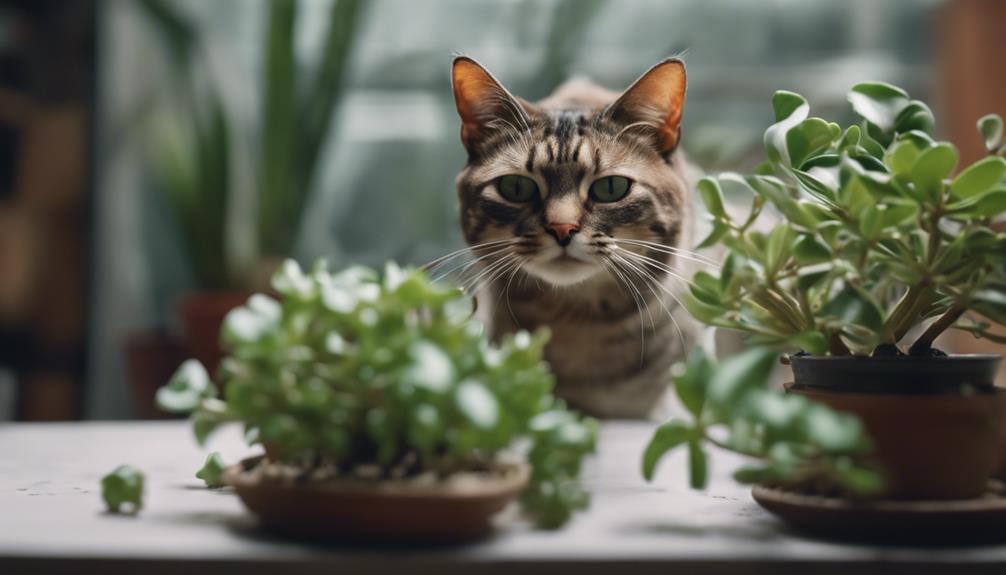
The Jade plant, a common succulent often found in households, poses a risk of toxicity to cats if ingested. Cats may experience symptoms such as vomiting and incoordination upon ingestion of this plant.
To ensure your cat's safety, here are some essential points to consider:
- Symptoms: Keep an eye out for signs of poisoning such as vomiting, lethargy, and lack of appetite if you suspect your cat has ingested the Jade plant.
- Immediate Action: Contact your vet promptly if you observe any concerning symptoms in your cat after potential exposure to the Jade plant.
- Preventive Measures: Place the Jade plant out of your cat's reach and consider opting for cat-friendly plants to avoid any accidental ingestion.
Risks of Pencil Cactus
In considering the potential dangers of the Pencil Cactus to cats, it is crucial to understand the specific risks associated with this succulent plant.
The Pencil Cactus, also known as Euphorbia tirucalli, contains a milky white sap that can cause irritation to a cat's mouth and stomach if ingested. This sap is a toxic irritant and can lead to symptoms such as drooling, vomiting, and diarrhea in cats.
Additionally, contact with the sap can cause skin irritation in both cats and humans.
Due to these potential risks, it is important to keep Pencil Cactus plants out of reach of pets and to seek veterinary care immediately if ingestion or contact is suspected.
Dangers of Silver Jade Plant
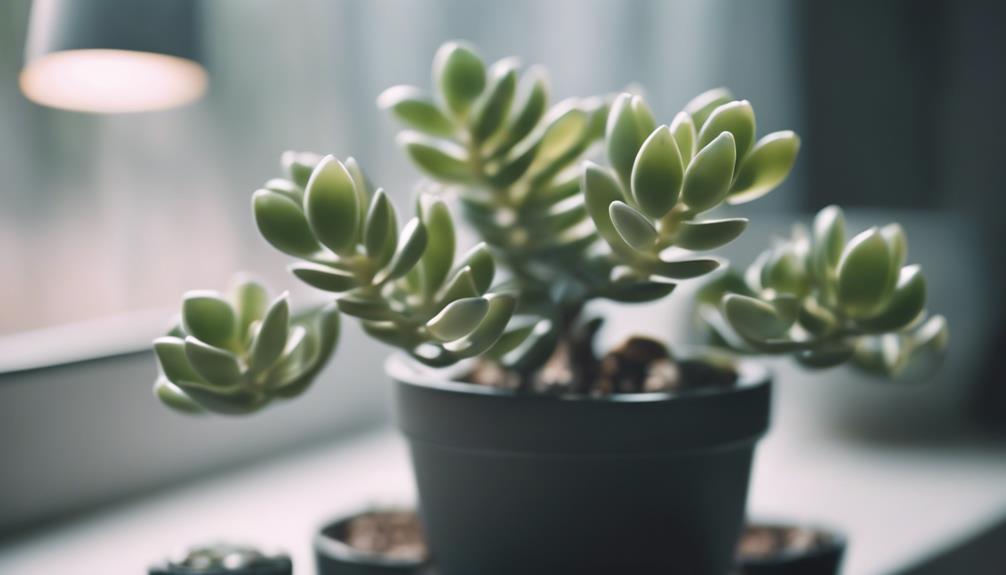
Considering the risks associated with toxic succulents for cats, the Silver Jade Plant poses a threat due to its potential to induce vomiting and tremors if ingested. This popular succulent, scientifically known as Crassula arborescens or Crassula ovata Gollum, contains toxic compounds that can harm cats when consumed.
To keep your feline friend safe from the dangers of the Silver Jade Plant, here are some important points to consider:
- Symptoms: Watch out for signs of poisoning such as excessive vomiting and tremors.
- Immediate Actions: If you suspect your cat has ingested the Silver Jade Plant, contact your veterinarian immediately.
- Preventive Measures: Keep this succulent out of reach of your cat to avoid accidental ingestion.
Toxicity of Snake Plant
The potential toxicity of the Snake Plant makes it essential for cat owners to be aware of the risks associated with this succulent. Also known as Sansevieria, Snake Plants contain saponins that can cause gastrointestinal issues in cats if ingested.
Symptoms of poisoning may include nausea, vomiting, and diarrhea. While these plants are popular for their air-purifying qualities and low maintenance, they can pose a danger to feline companions.
To prevent accidental ingestion, it is advisable to keep Snake Plants out of reach of cats or opt for cat-safe alternatives. If a cat shows signs of poisoning after exposure to a Snake Plant, immediate veterinary attention should be sought to address any potential health concerns.
Cat-Safe Succulents List
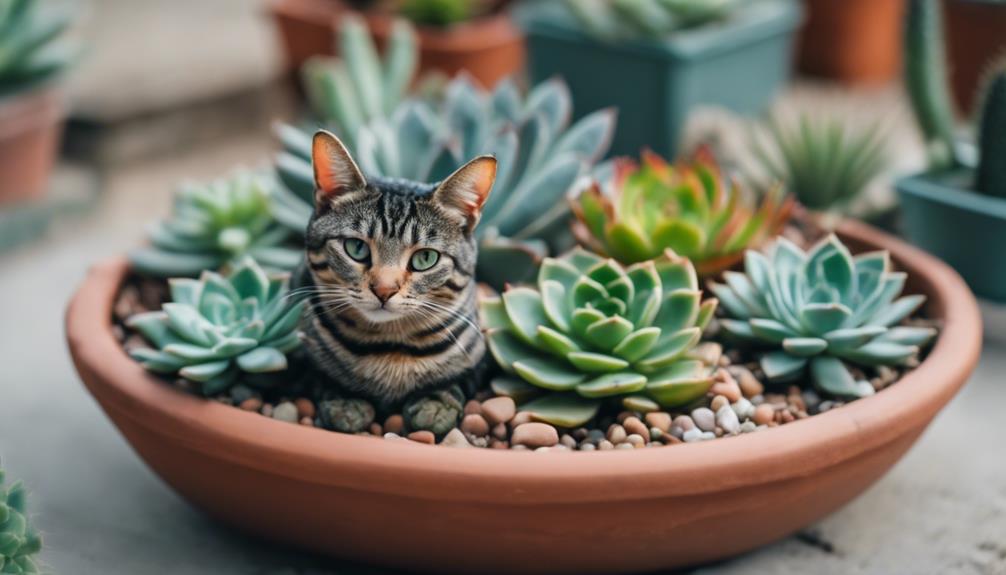
When selecting succulents for a cat-friendly environment, prioritizing safe options is crucial to ensure the well-being of your feline companion. Here are three cat-safe succulents to consider adding to your home:
- Chinese Money Plant (Pilea peperomioides): Known for its round, flat leaves, this plant is non-toxic to cats, making it a safe addition to your indoor garden.
- Hens and Chicks (Sempervivum Sp.): These rosette-shaped succulents are not harmful to cats, allowing you to enjoy their unique appearance without worrying about your pet's safety.
- Variegated Wax Plant (Echeveria Sp.): With its striking colors and patterns, this succulent is a safe option for cat owners looking to add a touch of beauty to their space.
Benefits of Chinese Money Plant
With its distinctive round, flat leaves and air-purifying properties, the Chinese Money Plant stands out as a beneficial addition to any indoor space.
This plant, also known as Pilea peperomioides, not only adds a touch of greenery to your home but also offers several benefits.
The Chinese Money Plant is easy to care for, making it suitable for both experienced and novice plant owners. It is known for its ability to remove toxins from the air, promoting a healthier indoor environment.
Additionally, this plant is believed to bring good luck and prosperity, making it a popular choice for those looking to add a touch of positivity to their living spaces.
Hens and Chicks Safety
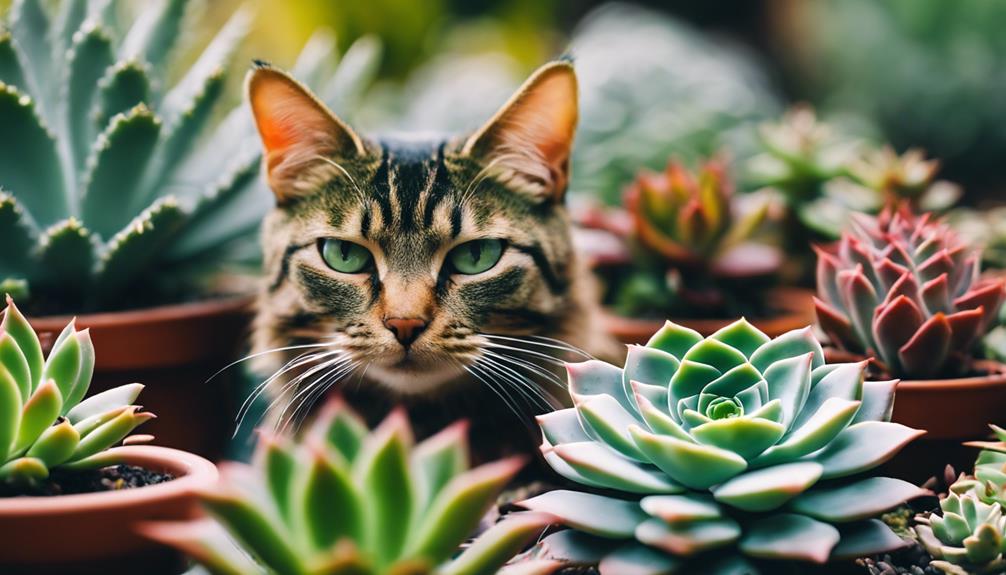
Hens and Chicks succulents, scientifically known as Sempervivum Sp., are renowned for their resilience and ease of care, making them a popular choice for cat owners seeking pet-safe indoor plants. These plants not only add a touch of greenery to your home but also offer a safe environment for your feline companions.
Here are three key points to consider regarding the safety of Hens and Chicks succulents for cats:
- Non-Toxic: Hens and Chicks succulents are non-toxic to cats, making them a safe option to have around your pets.
- Low Maintenance: These succulents are low-maintenance and hardy, requiring minimal attention while still thriving in various indoor conditions.
- Pet-Friendly Decor: Hens and Chicks succulents can serve as both decorative elements and safe companions for your cats.
Variegated Wax Plant Details
The Variegated Wax Plant, scientifically categorized as Echeveria Sp., is a visually striking succulent known for its vibrant colors and unique rosette shape. This succulent is characterized by its thick, fleshy leaves that often display a stunning blend of colors, including shades of green, pink, purple, and even blue.
Variegated Wax Plants are relatively easy to care for, requiring ample sunlight and well-draining soil to thrive. They are popular choices for both indoor and outdoor settings, adding a pop of color to any space.
While these plants are safe for cats, it's still essential to monitor your pets around them to prevent any potential ingestion or damage to the plant.
Blue Echeveria Care Tips
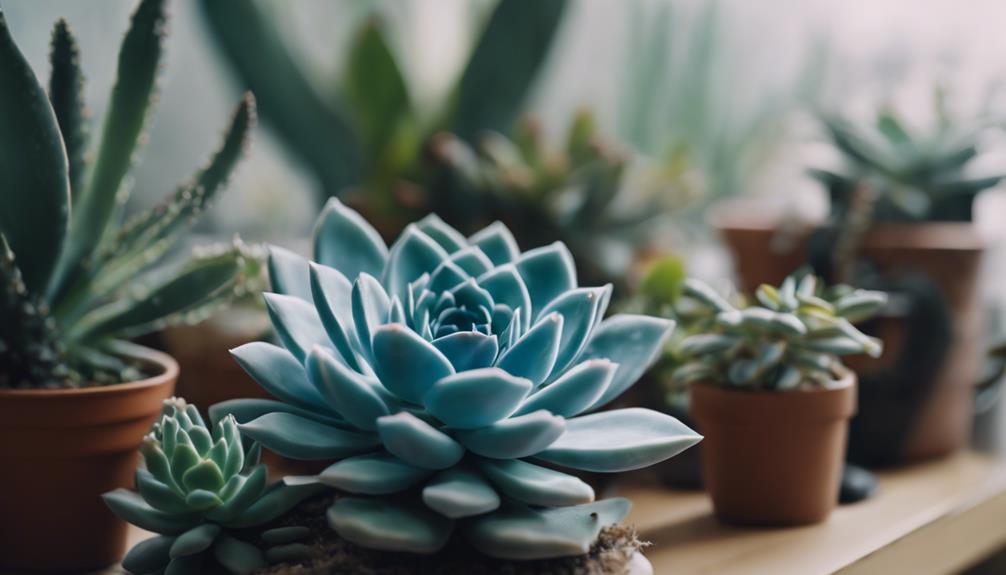
What key care considerations are essential for maintaining the vibrant and health of Blue Echeveria succulents? Blue Echeveria, also known as Maroon Chenille Plant, are stunning succulents that require specific care to thrive. Here are three crucial care tips to keep your Blue Echeveria healthy and vibrant:
- Sunlight: Place your Blue Echeveria in a location that receives bright, indirect sunlight for at least six hours a day. Direct sunlight can scorch the leaves, so filtered light is ideal.
- Watering: Allow the soil to dry out completely between waterings. Overwatering can lead to root rot, so it's essential to water sparingly but deeply when needed.
- Well-Draining Soil: Blue Echeveria plants thrive in well-draining soil. Use a cactus or succulent mix to ensure proper drainage and prevent waterlogged roots.
Burros Tail Hanging Option
For those seeking a decorative and safe hanging option, Burros Tail succulents provide an elegant solution that adds a touch of greenery to any space. Burros Tail, also known as Sedum morganianum, features trailing stems adorned with plump, teardrop-shaped leaves, giving it a unique and eye-catching appearance.
This succulent is safe for cats, making it a worry-free choice for pet owners looking to incorporate plants into their homes without risking their feline friends' health. When placed in a hanging basket or container, Burros Tail cascades beautifully, creating a lovely display that can brighten up any room or outdoor area.
Its low-maintenance nature and safe properties make it a popular choice for both cat owners and plant enthusiasts alike.
Conclusion
In conclusion, understanding the toxicity levels of various succulent species is essential for ensuring the safety of cats in a household. By being aware of which succulents are safe and which to avoid, pet owners can create a secure environment for their furry companions.
Consulting experts in the field can provide valuable insights into the potential risks associated with certain succulents, allowing for informed decisions to be made to protect the well-being of cats in the home.




